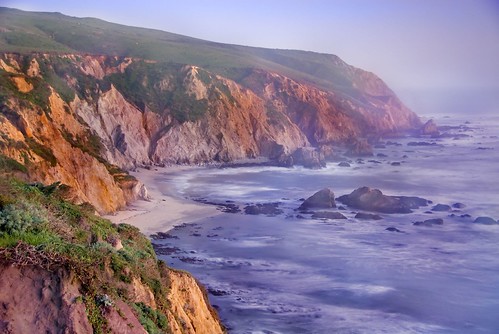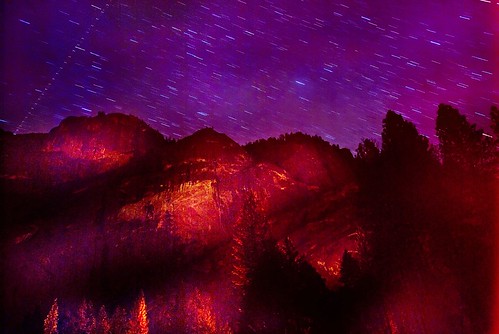OK, let’s start with two questions. Would you think the photo above was taken into almost complete night? And why would someone go to a great deal of trouble to hike out into the wilds somewhere, mount their camera on a tripod, and take a long time exposure into total darkness?
The answer to the first question is, “Yes, the sun was long down, and if it wasn’t quite pitch-black night, it was certainly hard-to-see gray twilight darkness.” And I think this answer to the first question also answers the second, explaining why night photography has become one of my new passions. Digital photography just does not render the scene after dark in the way we see it (or in the way film did), and some of the effects are startlingly interesting.
Still not convinced? Here’s another photograph, exposed for five minutes in the night of Yosemite Valley:
View this image larger. Read more about this image.
Supposing that I can convince you to join me in my newfound love of photographing the dark, there are some things you should keep in mind. Darkness is not light, and it is hard to see in the dark. You should take simple safetyprecautions like bringing a good light source, dressing warmly, and letting someone responsible know where you are going.
A good tripod is a must for night photography.
Night exposures are a matter of trial and error. These exposures take guess work and experience is what it is, which is part of what makes this so much fun, because it is challenging. The good news, of course, with a digital camera is that you can get immediate feedback on your photo, although with my Nikon D200 processing these long exposure images takes about half as long as the exposure itself (and you won’t see th eimage on the LCD until it has been processed).
If you have a scene that is lit by bright starlight, try ISO 100 at 90 seconds and somewhere between f/4 and f/11 for a first exposure.
Make sure your camera is set to process the noise from a long exposure, if this setting is on one of the menus.
What also helps is taking exposures as the light fades, that way you’ll already be in the right ballpark.
You’ll want a remote cable that is programmable, so you can set it for a long Bulb exposure without having to hold the shutter button down. (Here’s some info about working with the Nikon remote MC-36 cable.)
If you want to learn more, have a look at On Night Photography.


Pingback: Photoblog 2.0: » Photoblog 2.0 Archive: » Mount Tamalpais at Night
Pingback: Photoblog 2.0: » Photoblog 2.0 Archive: » Tennessee Valley at Night
Pingback: Photoblog 2.0: » Photoblog 2.0 Archive: » Star Light Star Bright
Pingback: Photoblog 2.0: » Photoblog 2.0 Archive: » Eucalyptus Grove in the Fog
Pingback: Photoblog 2.0: » Photoblog 2.0 Archive: » Night Shore
Pingback: Photoblog 2.0: » Photoblog 2.0 Archive: » Midnight Rambles